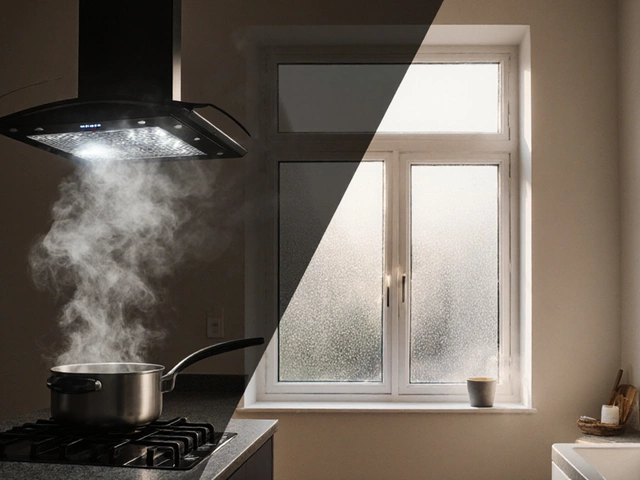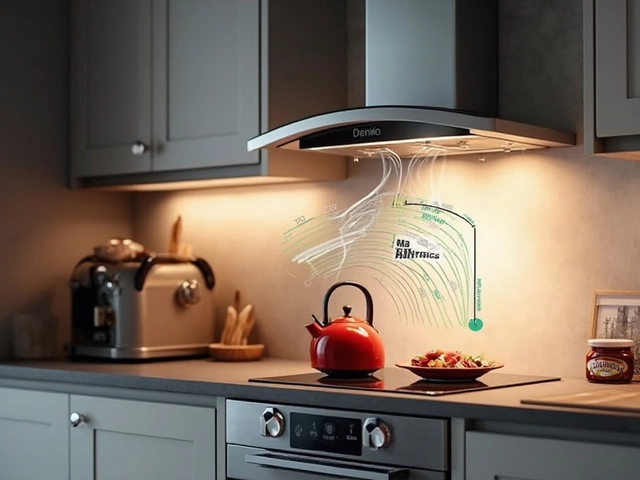Ever tried figuring out why your kitchen smells hang around or why your bathroom is always muggy? The right fan can make a massive difference. But here’s the catch: not all fans are the same. Some folks use the terms ‘ventilation fan’ and ‘extractor fan’ like they mean the same thing, but they’re doing very different jobs at home.
Ventilation fans and extractor fans look similar, but the problems they solve are pretty specific. From pulling out humid air after a hot shower to clearing out frying smells from your last dinner experiment, the right fan sets the tone for air you can actually breathe. Getting them mixed up is a recipe for frustration—and wasted money.
If you’re fed up with foggy mirrors, peeling paint, or just can’t take another whiff of last night’s burnt toast, getting clear on which fan you need is key. Knowing the difference can save your walls, your lungs, and probably your next repair bill. Stick around—you might be surprised how much easier it is to pick the right one once you know what each is built for.
- Ventilation Fans: What Do They Actually Do?
- Extractor Fans: Purpose and Key Features
- Main Differences: Side-by-Side Comparison
- Choosing the Right Fan for Your Space
- Common Troubles and Repair Tips
Ventilation Fans: What Do They Actually Do?
Ventilation fans are all about keeping air moving inside your home. Think of them as your main defenders against stuffy rooms, trapped heat, and those weird lingering smells. The job of a ventilation fan isn’t just to get air out—it’s to keep fresh air coming in too. You’ll usually find these fans in places like living rooms, hallways, offices, and sometimes larger commercial spaces where air can get stale fast.
A ventilation fan works by trading out dirty, humid, or hot indoor air for cleaner, cooler air from outside. They don’t just suck air out—they help push fresh air in, balancing everything out so you don’t get hot spots or funky corners where air just sits. These fans make sure the whole room is breathing, not just a little corner near a window.
Here’s where ventilation fans really prove their worth:
- Keeping indoor air fresh and comfortable, even when windows are closed.
- Helping with asthma and allergies by moving out dust, pollen, and other irritants.
- Stopping humidity from ruining your walls, floors, or electronics.
- Cutting down on energy bills by reducing how hard your AC or heater needs to work.
One interesting stat: Properly placed ventilation fans can help cut indoor air pollution by around 30%, according to data from indoor air quality studies. That’s not just theory—folks with good ventilation systems actually report fewer headaches and better sleep, especially in busy homes or places with pets or smokers.
| Space Type | Fan Size Needed | Typical Placement |
|---|---|---|
| Living Room | 100-150 CFM | Wall or ceiling near center |
| Bedroom | 50-100 CFM | Wall away from main door |
| Office | 100-200 CFM | Ceiling, near central HVAC vent |
If you’ve ever walked into a room and it just smelled "old" or felt muggy, you’ve seen what happens when ventilation fans aren’t doing their job. And if you’ve got electronics, musical instruments, or even paper files inside, good ventilation can actually keep them from getting damaged by all that extra moisture.
Extractor Fans: Purpose and Key Features
Extractor fans are built for one job: to suck out unwanted air, like moisture, smoke, or smells, straight out of your home. They’re usually found in bathrooms, kitchens, or even laundry rooms—any place where air needs to get out fast.
These fans don’t just circulate air inside the same room—they pull it outside, usually using a duct system. That’s why a clogged or broken extractor fan means more than just a bit of noise. If the fan can’t pull moisture out, it can literally cause mold, peeling paint, and a never-ending battle with foggy mirrors.
Extractor fan is the key keyword here, and for good reason—they’re often the first line of defense against damp. You’ll spot them near your stove or above a shower. The power of an extractor fan is measured in cubic meters per hour (m³/h), which tells you how much air it can shift. A good kitchen extractor fan pushes out at least 150-300 m³/h, according to most UK building standards.
"Extractor fans aren’t just nice to have, they’re essential in controlling moisture and cutting down on household pollutants like nitrogen dioxide and fine particles from cooking." — UK National Health Service air quality guidelines
There are a few types you’ll likely come across:
- Inline extractor fans: Fitted in your ceiling or loft, these are out of sight but behind the scenes, doing the heavy lifting.
- Axial extractor fans: Best for short duct runs and easy installs, you spot them on bathroom walls or windows.
- Centrifugal fans: More powerful, designed for ductwork with bends and longer runs—perfect for rooms far from the outside wall.
Check out how they stack up when it comes to noise and airflow, two things everybody cares about:
| Type | Typical Noise (dB) | Airflow (m³/h) |
|---|---|---|
| Axial | 30-45 | 80-180 |
| Inline | 25-38 | 100-250 |
| Centrifugal | 40-55 | 170-350 |
One more detail: extractor fans need regular cleaning. Dust and gunk mess with the fan’s ability to pull out air, making the room damp and stuffy. If you start seeing water stains or feel like your kitchen still smells hours after cooking, your fan probably needs a check-up.

Main Differences: Side-by-Side Comparison
If you’ve ever stood in a store staring at boxes labeled “ventilation fan” and “extractor fan,” you know how confusing this gets. Here’s what actually sets them apart.
Ventilation fan is most often about moving fresh air inside—a general freshening up, you could say. Extractor fans, though, pull out bad air, smoke, moisture, or fumes right out of the room and send it outside. They don’t swap air—they push it out. That’s why you’ll find extractor fans right above your hob or in bathrooms where you’re fighting steam and mold.
- Ventilation Fans: Circulate air, help control temperature, and sometimes filter dust or pollen. These are common in living rooms, offices, or anywhere you want better air flow in general.
- Extractor Fans: Remove moisture, steam, or bad smells right from the source. Essential in kitchens, bathrooms, or workshops where fumes and damp build up fast.
Take a look at how they work differently in practice:
| Feature | Ventilation Fan | Extractor Fan |
|---|---|---|
| Main Purpose | Brings in fresh air or circulates indoor air | Expels stale, humid, or contaminated air |
| Installation Areas | Living rooms, bedrooms, offices | Kitchens, bathrooms, workshops |
| Air Flow Direction | Outdoors to indoors, or around a space | Indoors to outdoors |
| Filters Odors and Grease? | Rarely | Often includes filters |
| Typical Noise | Quieter | May be louder |
| Moisture Control | Low | High |
The differences add up when you look at real-life problems. Cooking up a storm? An extractor fan above the stove will grab those smells way better than a regular fan. Dealing with stuffy air in the bedroom? That’s where a ventilation fan shines.
One more tip: Some modern systems combine both features, but knowing which function you need most can save you both hassle and cash when choosing or repairing a fan. If you’re not sure which one is installed at home, check where the air is going. If it’s blowing outside, you’ve got an extractor. If it’s just moving stuff around inside, that’s a standard ventilation fan.
Choosing the Right Fan for Your Space
Picking out the right fan isn’t just about grabbing the first one you see at the hardware store. You need to match the fan to your space, your needs, and even your habits. Here’s how to make the right call and avoid buying the wrong thing.
If you’re thinking about installing a ventilation fan or an extractor fan, start by thinking about what you actually want the fan to do. Bathroom full of steam every morning? Or is your kitchen the kind of place where bacon leaves a cloud? The type of air problem you have decides the fan you need.
- Bathrooms: You need a fan that fights off humidity, clears out steam, and keeps mold in check. That means a fan rated for high moisture with a good extraction rate (measured in m³/h or CFM—cubic feet per minute). For an average bathroom, something between 50–110 CFM usually gets the job done.
- Kitchens: Here, it’s about getting rid of cooking smells, smoke, and grease. Go for a more powerful extractor fan—look for at least 100–200 CFM, or higher if you’re cooking a lot.
- Bedrooms & Living Rooms: These areas might only need a ventilation fan to keep the air moving. Usually, 30–50 CFM is enough for small to medium rooms.
Don’t skip the sizing math. A too-small fan won’t clear the air, and a too-big one is noisy and wastes energy. Measure your room (length x width x height = volume) and check the box for the fan’s capacity. It’s smarter to pick a fan a little above your minimum requirement but not by a huge margin.
| Room Type | Recommended Fan Type | Typical CFM/Capacity |
|---|---|---|
| Bathroom (Small-Medium) | Extractor/Ventilation Fan | 50-110 CFM |
| Kitchen | Extractor Fan | 100-200 CFM+ |
| Bedroom/Living Room | Ventilation Fan | 30-50 CFM |
If you want extra features, some fans now come with humidity sensors, timers, or even smart controls you can tie to your phone. They cost a little more but make life easier—no more flipping the switch and forgetting to turn it back off.
Last thing: look out for fan noise levels, measured in sones. Seemingly small fans can sound like mini jet engines. Go for a sone rating of 1.5 or less if you want something that won’t drown out your podcasts or sleep.
Getting the right fan now means fewer repairs and less hassle later. Don’t cut corners, especially if this is for a spot where moisture or smells are a real problem.

Common Troubles and Repair Tips
Even the best fans run into problems, whether you’ve got a ventilation fan in the ceiling or an extractor fan above your stove. Most issues come down to dirt build-up, dodgy wiring, or worn-out components, but there’s usually a fix if you catch it early. Here’s what typically goes wrong and what you can do about it.
- Fan not turning on: The main culprit is almost always a blown fuse or a tripped circuit breaker. If the power’s fine, check any wall switches or pull cords attached to the fan.
- Weak airflow: This often means your fan’s clogged up with dust, grease, or even spiderwebs. In kitchens, extractor fans can get gunked up fast with cooking residue. Bathroom fans collect lint and hair. Cleaning the grilles and blades usually perks things up.
- Strange noises: Rattling or buzzing usually points to loose screws, a bent blade, or a bit of debris stuck somewhere it shouldn’t be. For older models, worn bearings can make a grinding noise, meaning it might be time for a replacement motor or a completely new fan.
- Fan runs but air isn’t moving: Ducts blocked by insulation, nests, or even a stuck flap at the outside wall let your fan spin but not actually do its job. Always inspect the whole air path, from the fan to the exhaust outlet.
If you’re handy and want to do the job yourself, here’s a basic clean-up that solves most issues:
- Turn off the power at the breaker—don’t trust just switching it off on the wall.
- Remove the cover or grille with a screwdriver.
- Wash the cover in warm, soapy water and let it dry.
- Use a vacuum or a damp cloth to clean dust and debris off the blades and motor area—don’t soak the motor!
- Reassemble and turn the power back on. Test the fan.
You’d be surprised—regular cleaning (just a couple times a year) easily doubles the lifespan of most ventilation fans and extractor fans. For kitchens, aim for every 3-4 months due to grease build-up. In bathrooms, every 6 months usually does the trick.
Spotting an electrical smell, melted wires, or burn marks? Don’t mess around—this is one for a pro. And if your fan is older than 10-12 years or still underperforming after cleaning, it’s probably time for a replacement.
| Trouble | Possible Cause | Quick Fix |
|---|---|---|
| No Power | Blown fuse, faulty wiring | Check breaker, replace fuse |
| Weak Airflow | Dust or grease build-up | Clean grille and blades |
| Noisy Operation | Loose parts, bearing wear | Tighten screws, replace if needed |
| Running but Not Extracting | Blocked duct or vent | Clear duct and outside flap |




